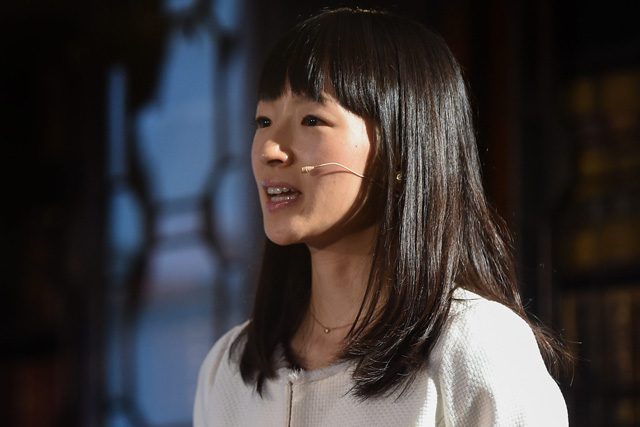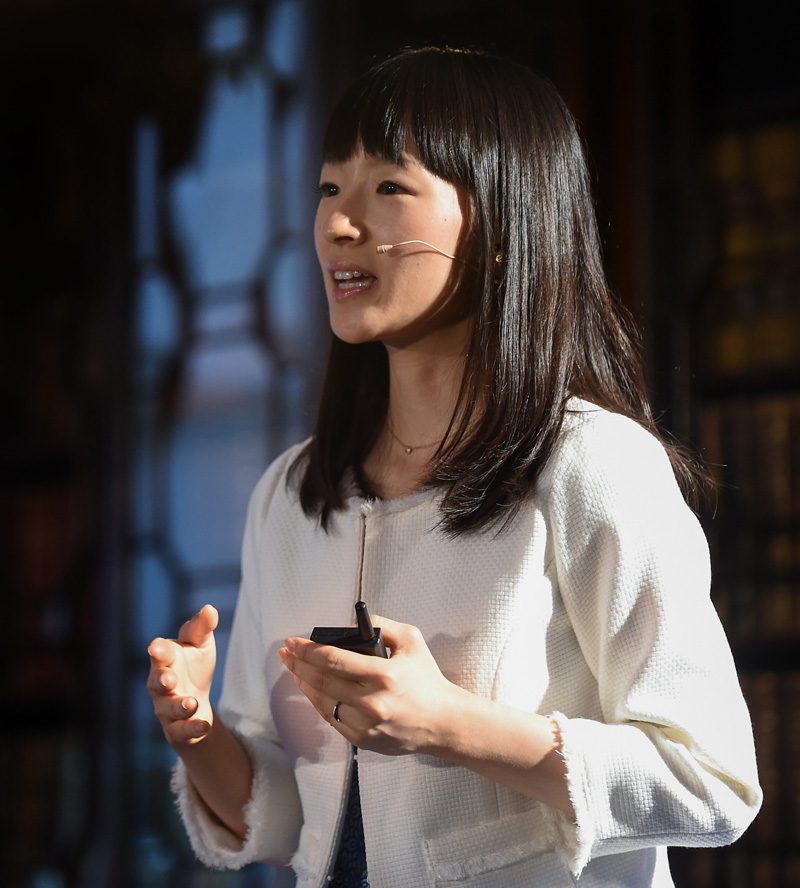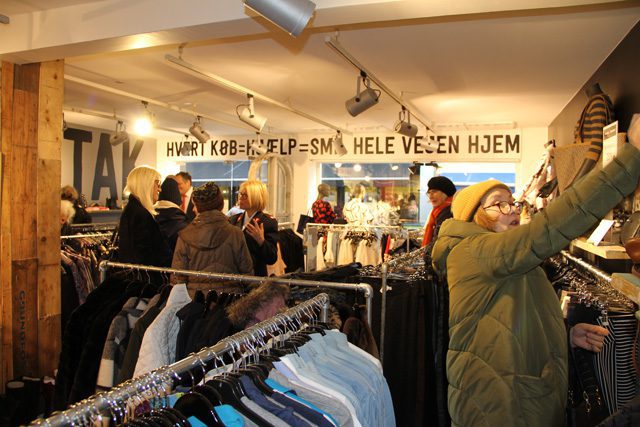Listen to this article
Listen to this article
Loading
Play
Pause
Options
0:00
-:--
1x
Playback Speed- 0.5
- 0.6
- 0.7
- 0.8
- 0.9
- 1
- 1.1
- 1.2
- 1.3
- 1.5
- 2
Audio Language
- English
- French
- German
- Italian
- Spanish
Open text
‘marie kondo effect’ finds its way into thrift stores. netflix craze sees more americans bulldozing their closets and calling the salvation army. by vivian lopez –. japanese tidying expert marie kondo kicked off 2019 by taking households across the country by storm with her popular netflix show, “tidying up with marie kondo.” the series—which features kondo helping families declutter and organize their homes—encourages viewers to do the same and only keep items that “spark joy.”. this past january—the same month the show premiered—donation pickups for salvation army western territory thrift stores increased by 14 percent compared to january 2018, according to dalita lovett, western territory adult rehabilitation center (arc) command director of resource development. she said that while there is usually a higher volume of donations after the new year, this year’s surge easily outpaced those of years past. and while it’s difficult to attribute that growth entirely to the “konmari” phenomenon, lovett believes the show has certainly been a contributing factor. “new year’s resolutions have never had this effect before. there is something bigger going on,” she said. “marie kondo’s show seems to be really resonating with americans in a profound way. people are trying to find joy in their lives. the show is propelling that for sure, but i think that a lot of things we’re doing in and out of the stores and our donation sites are helping get the word out, as well.”. arc command general secretary henry graciani noted that while correlation doesn’t necessarily imply causation, series like kondo’s that promote minimalism do have the potential to spark more donations to secondhand stores. “the more interest or the more attention that’s put on the idea of organizing or spring cleaning or downsizing or minimizing certainly impacts the salvation army because people are looking at ways of getting rid of items rather than throwing them in the landfill or the trash can,” graciani said. “they can repurpose it by giving it to the salvation army.”. that held especially true at the arc donation warehouse in oakland, california, which experienced the highest year-over-year donation spike in the territory. its trainee-in-charge, major daniel freeman, said donors frequently mentioned “tidying up” as donations swelled for its three stores. marie kondo has had such a profound impact on netflixers that many salvation army thrift store networks have had to beef up on staff and overtime hours. “as the donations started coming in, especially with the people dropping off stuff, there were quite a few of them that mentioned or referenced [marie kondo] and her netflix show,” freeman said. “we don’t know any other reason why people suddenly were giving us all their donations like they were.”. captain paul swain, seattle arc administrator for business, said not even snow and icy roads could slow the influx of donations for the seattle arc’s two thrift stores. “it just seems like there’s a buzz in the air,” swain said. “there just a higher level of joy in giving.”. the “marie kondo effect”. these salvation army thrift store networks experienced the biggest percentage increase in donation pickups in the western territory from january 2018 to january 2019:. oakland, california: 67.2%. seattle, washington: 60.7%. san diego, california: 47.4%. las vegas, nevada: 45.2%. pasadena, california: 44.3%. source: usa western territory adult rehabilitation center command. james durland, san diego, california, arc warehouse and collection sites director of production, said that aside from a significant overall jump in donations, he noticed staggering number of clothing donations to the seven san diego area stores. “i’ve been here for nine years and haven’t seen this influx of clothes before,” durland said. freeman likewise said the lion’s share of recent donations to the oakland arc thrift stores have been clothing, one of the main focuses of the konmari method. the cascade of donated goods has not come without challenges, however. the san diego arc donation warehouse has had to stay open seven days a week to accept, pick up and process donations. the seattle arc has had to adjust pickup routes—sometimes with a third trailer out for pickups. and several stores have had to hire additional workers and approve additional work shifts and overtime hours to keep up. “it’s a good thing for us. it created more work for everybody,” freeman said. “we had to get a lot more creative in how we’re storing and holding all these goods that we could get processed, but we were able to figure it out…the clothes and whatever it is that isn’t really contributing much to [the donors’] lives, contributes significantly to the lives of the men in our program here. it’s that clothing that helps us be able to run this 119-bed facility and take care of these men who have no other option and no hope left in their lives, and help them get to a place where they could be successful in their recovery so they can function in society again.”. graciani hopes donors continue to bring in their donations to the salvation army as they declutter their homes—whether through the konmari method or not. “the more the people contribute, the more our stores can have better product and more product, which means we can generate more revenue simply to help more people,” graciani said. “the fuel for our engine is donated goods. the donors of the salvation army help men and women rebuild their lives and restore their families.”. learn more about the salvation army’s addiction recovery programs across the u.s. and schedule a donation pickup at satruck.org.
Open context player
Close context player
Plays:-Audio plays count
‘marie kondo effect’ finds its way into thrift stores. netflix craze sees more americans bulldozing their closets and calling the salvation army. by vivian lopez –. japanese tidying expert marie kondo kicked off 2019 by taking households across the country by storm with her popular netflix show, “tidying up with marie kondo.” the series—which features kondo helping families declutter and organize their homes—encourages viewers to do the same and only keep items that “spark joy.”. this past january—the same month the show premiered—donation pickups for salvation army western territory thrift stores increased by 14 percent compared to january 2018, according to dalita lovett, western territory adult rehabilitation center (arc) command director of resource development. she said that while there is usually a higher volume of donations after the new year, this year’s surge easily outpaced those of years past. and while it’s difficult to attribute that growth entirely to the “konmari” phenomenon, lovett believes the show has certainly been a contributing factor. “new year’s resolutions have never had this effect before. there is something bigger going on,” she said. “marie kondo’s show seems to be really resonating with americans in a profound way. people are trying to find joy in their lives. the show is propelling that for sure, but i think that a lot of things we’re doing in and out of the stores and our donation sites are helping get the word out, as well.”. arc command general secretary henry graciani noted that while correlation doesn’t necessarily imply causation, series like kondo’s that promote minimalism do have the potential to spark more donations to secondhand stores. “the more interest or the more attention that’s put on the idea of organizing or spring cleaning or downsizing or minimizing certainly impacts the salvation army because people are looking at ways of getting rid of items rather than throwing them in the landfill or the trash can,” graciani said. “they can repurpose it by giving it to the salvation army.”. that held especially true at the arc donation warehouse in oakland, california, which experienced the highest year-over-year donation spike in the territory. its trainee-in-charge, major daniel freeman, said donors frequently mentioned “tidying up” as donations swelled for its three stores. marie kondo has had such a profound impact on netflixers that many salvation army thrift store networks have had to beef up on staff and overtime hours. “as the donations started coming in, especially with the people dropping off stuff, there were quite a few of them that mentioned or referenced [marie kondo] and her netflix show,” freeman said. “we don’t know any other reason why people suddenly were giving us all their donations like they were.”. captain paul swain, seattle arc administrator for business, said not even snow and icy roads could slow the influx of donations for the seattle arc’s two thrift stores. “it just seems like there’s a buzz in the air,” swain said. “there just a higher level of joy in giving.”. the “marie kondo effect”. these salvation army thrift store networks experienced the biggest percentage increase in donation pickups in the western territory from january 2018 to january 2019:. oakland, california: 67.2%. seattle, washington: 60.7%. san diego, california: 47.4%. las vegas, nevada: 45.2%. pasadena, california: 44.3%. source: usa western territory adult rehabilitation center command. james durland, san diego, california, arc warehouse and collection sites director of production, said that aside from a significant overall jump in donations, he noticed staggering number of clothing donations to the seven san diego area stores. “i’ve been here for nine years and haven’t seen this influx of clothes before,” durland said. freeman likewise said the lion’s share of recent donations to the oakland arc thrift stores have been clothing, one of the main focuses of the konmari method. the cascade of donated goods has not come without challenges, however. the san diego arc donation warehouse has had to stay open seven days a week to accept, pick up and process donations. the seattle arc has had to adjust pickup routes—sometimes with a third trailer out for pickups. and several stores have had to hire additional workers and approve additional work shifts and overtime hours to keep up. “it’s a good thing for us. it created more work for everybody,” freeman said. “we had to get a lot more creative in how we’re storing and holding all these goods that we could get processed, but we were able to figure it out…the clothes and whatever it is that isn’t really contributing much to [the donors’] lives, contributes significantly to the lives of the men in our program here. it’s that clothing that helps us be able to run this 119-bed facility and take care of these men who have no other option and no hope left in their lives, and help them get to a place where they could be successful in their recovery so they can function in society again.”. graciani hopes donors continue to bring in their donations to the salvation army as they declutter their homes—whether through the konmari method or not. “the more the people contribute, the more our stores can have better product and more product, which means we can generate more revenue simply to help more people,” graciani said. “the fuel for our engine is donated goods. the donors of the salvation army help men and women rebuild their lives and restore their families.”. learn more about the salvation army’s addiction recovery programs across the u.s. and schedule a donation pickup at satruck.org.
Listen to this article














